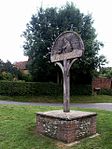River Tiffey
AC with 0 elementsEngland river stubsRivers of NorfolkYare catchment

The River Tiffey is a small river in Norfolk, England and a tributary of the River Yare. It rises near Hethel and passes through Wymondham before flowing generally north-eastwards passing through Kimberley, Carleton Forehoe, Wramplingham and Barford where the Tiffey joins the River Yare.
Excerpt from the Wikipedia article River Tiffey (License: CC BY-SA 3.0, Authors, Images).River Tiffey
Watton Road, South Norfolk
Geographical coordinates (GPS) Address Nearby Places Show on map
Geographical coordinates (GPS)
| Latitude | Longitude |
|---|---|
| N 52.6249 ° | E 1.1361 ° |
Address
Watton Road
Watton Road
NR9 4BQ South Norfolk
England, United Kingdom
Open on Google Maps










